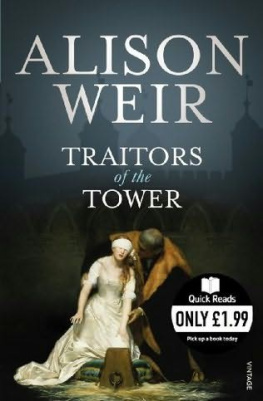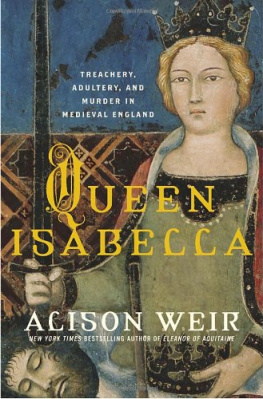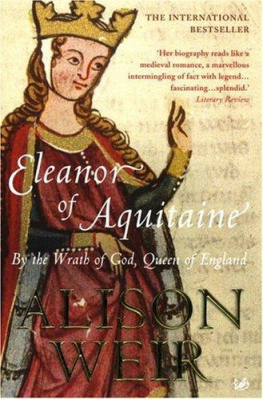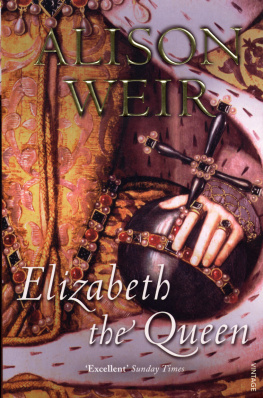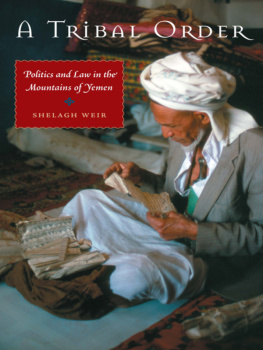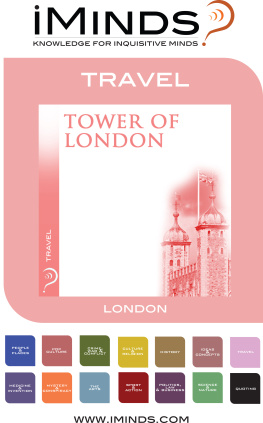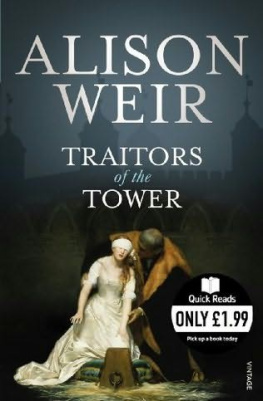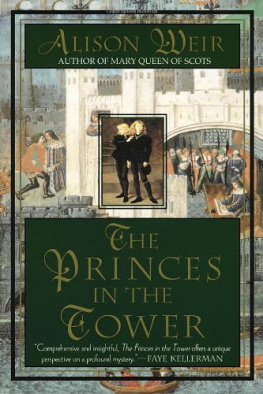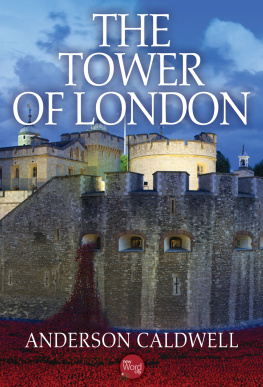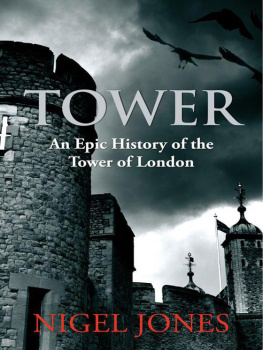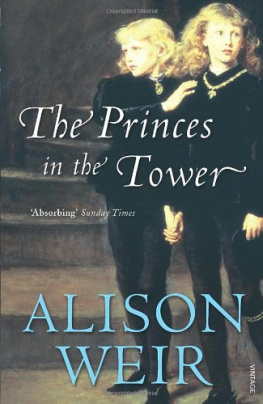Traitors of the Tower
Alison Weir was born in London, England, and went to the City of London School. Her great love of history started when she read her first novel. Later, she trained as a teacher. She now lives and works in Surrey and her books include Britains Royal Families, The Six Wives of Henry VIII and Mary Queen of Scots and the Murder of Lord Darnley. She has also published two novels, Innocent Traitor and The Lady Elizabeth.
Also by Alison Weir
Non-Fiction
Britains Royal Families: The Complete Genealogy
The Six Wives of Henry VIII The Princes in the Tower
Lancaster and York: The Wars of the Roses
Children of England: The Heirs of King Henry VIII
15471558
Elizabeth the Queen
Eleanor of Aquitaine
Henry VIII: King and Court
Mary Queen of Scots and the Murder of Lord
Darnley
Isabella: She Wolf of France, Queen of England
Katherine Swynford: The Story of John of Gaunt and
His Scandalous Duchess
The Lady in The Tower: The Fall of Anne Boleyn
Fiction
Innocent Traitor
The Lady Elizabeth
Traitors of the Tower
Traitors of the Tower
Alison Weir
CONTENTS
Introduction
1. Lord Hastings (1483) The Kings Loyal Friend
2. Queen Anne Boleyn (1536) I Have a Little Neck
3. Margaret Pole, Countess of Salisbury (1541) Hacked to Death
4. Queen Katherine Howard (1542) Rose Without a Thorn
5. Jane Parker, Lady Rochford (1542) The Wicked Wife
6. Lady Jane Grey (1554) The Nine-Days Queen
7. Robert Devereux, Earl of Essex (1601) Strike Home!
Introduction
In the Tower of London, between 1483 and 1601, seven famous traitors lost their heads. Visitors are often drawn to the scaffold site on Tower Green where they are said to have died. In fact, five were put to death in a different place within the Tower, in front of what is now the Waterloo Barracks.
This book tells the grim and tragic stories of the traitors who died in the Tower.
Chapter One
Lord Hastings (1483) - The Kings Loyal Friend
Lord Hastings was the loyal friend of King Edward IV, the first monarch of the House of York. He helped Edward all his life, and shared his tastes for women and good food. Born around 1431, he came from a good Yorkshire family that had long supported the House of York against the House of Lancaster during the Wars of the Roses. In 1461 he had fought for Edward at the Battle of Towton, which gained Edward the throne. Hastings was given his title, vast lands and a seat on the royal council. He was also made a Knight of the Garter. He married Katherine, the sister of Warwick, the King-Maker, the man who had helped set Edward up as king.
Hastings was well liked by all. People praised his sense of duty, his charity and his love of the arts. He had great power and wealth, more than many of higher rank, and people only got to see the King with Hastings favour. But his power, and his wenching with the King, earned him the hatred of the Queen, Elizabeth Wydeville. Her family were his rivals for royal favour, and his deadly foes. Hastings was also rivals with Lord Dorset, the Queens elder son, for the love of Elizabeth Shore, the Kings mistress.
In April 1483, Edward IV died at the early age of forty-one. On his deathbed, he ordered Hastings, the Queen and Dorset to make peace, which they made a show of doing. Edwards son and heir was just twelve years old, so in his will he named his brother, Richard, Duke of Gloucester, as Lord Protector while the boy was too young to rule. But Gloucester was in the north, and after Edward had died, the Queen tried to seize power. Hastings was well aware that she might now take revenge on him, but his main concern was for the new young King, Edward V.
Edward V was then at Ludlow Castle on the Welsh border. As Prince of Wales, he had been learning how to rule his subjects. The Queen sent for him to come to London at once to be crowned. She wanted a great army to escort him, but Hastings thought this might provoke trouble and bloodshed. He won the day with threats against the Queens family, the Wydevilles, and so only a small escort went with the young King.
Gloucester too feared the Wydevilles, who had not told him of his brothers death. He learned of it from Hastings, who also wrote that the Queen meant to remove him from power. He told Gloucester to hurry to London with a strong force of men, and to take Edward V into his care on the way. Hastings added that he himself was in danger from the Queens party, and he could not wait for Gloucester to reach London.
Gloucester, wearing black for his brother, rode south at once with three hundred men. At Northampton, he met up with his ally, the Duke of Buckingham, and a large force. In London, Hastings told the royal council that the humble blood of the Queen and her family made them unfit to rule, and that Gloucester should govern the realm. This earned him no credit with the Wydevilles.
At Stony Stratford, Gloucester and Buckingham met up with Edward V and his escort, which was led by Earl Rivers, the Queens brother, and her younger son, Sir Richard Grey. Gloucester and Buckingham seized the King, arrested Rivers and Grey, who were put in prison, and then rode on to London with a very shocked Edward V.
The power of the Wydevilles had been broken at a stroke. The Queen, in great fear, now took sanctuary in Westminster Abbey with her younger son, Richard, Duke of York, and her five daughters. Hastings sent a message to assure her that all would be well, but she did not believe it. He had done his best to destroy her, she said.
London was in an uproar. Hastings tried to restore calm by telling the council that Gloucester had been faithful to the dead King, Edward IV, and would now be true to Edwards son. He had only arrested Rivers and Grey for his own safety. In saying this, Hastings turned many people against the Wydevilles. But there were some on the council who were wary of Gloucesters cunning.
Soon after arriving in London, Gloucester was in complete control of the young King and the country. He got rid of the Queens friends on the council, and sent Edward V to live in the palace in the Tower of London. The Tower was not yet known as a prison. Edward IV had held court there many times, and it was usual for a king to spend the days before his crowning at the Tower.
Hastings was pleased to see Gloucester in charge, and keen to do all he could for him. He showed much joy at this new world, which had been won without one drop of blood being shed.
But Gloucester knew he would never be safe. The young King was his mothers son, and it would only be a matter of time before he turned on his uncle. For his own safety, Gloucester had to make a bid for the throne itself. Some people thought he had plotted that all along.
Hastings was now part of Edward Vs small court in the Tower, helping the boy to learn how to rule. It was perhaps at this time that the young King gave him the fine book known as The Hastings Hours, which is now in the British Library in London. Gloucester kept Hastings in the important positions he had held under Edward IV, but there was no reward for helping him gain power. Gloucester loved him well, but he liked and trusted Buckingham more. He knew that Hastings was deeply loyal to Edward V, and would block any move to depose him. In Gloucesters mind Hastings was now an enemy.
On the face of it, all seemed well. Hastings had no reason to doubt Gloucester. But Lord Stanley, who did not trust Gloucester, warned him to be careful. Then Buckingham sounded out Hastings on how he would act if Gloucester claimed the throne. Hastings used terrible words, saying he would accept him as Protector for Edward V, but never as king and sealed his own doom.

